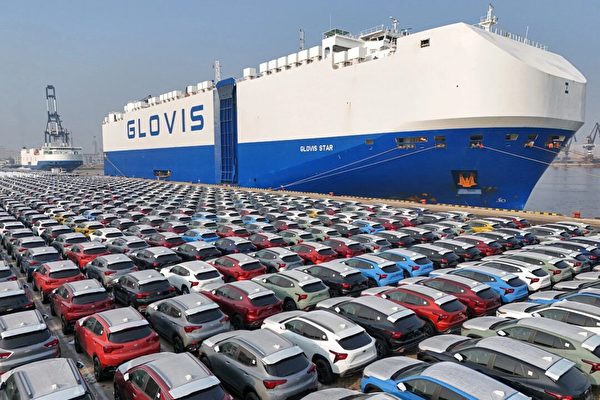Recently, another red signal heralds a crisis for the Chinese economy: lending and borrowing continue to decline. This phenomenon indicates deep-seated problems in the Chinese economy and finance. It is yet another iconic event signaling challenges and failures for the Chinese Communist regime.
According to the data recently released by the People’s Bank of China (PBOC), from January to March, the total amount of financing from banks and non-banks, referred to as “total social financing” by PBOC officials, amounted to 12.93 trillion yuan (approximately $1.78 trillion). Compared to the first quarter of last year, this amount decreased by 1.61 trillion yuan, a decline of about 11%. Additionally, in the first three months of 2024, banks issued loans totaling 9.46 trillion yuan, also significantly down from the same period in 2023. All data fell below the expectations of international economists.
The shortage of funds needed for economic growth is bound to bring significant troubles to the high-ranking officials of the Chinese Communist Party in Beijing. The issue is particularly severe because, despite the central bank injecting ample liquidity into the financial markets, this situation has still inevitably occurred. According to PBOC data, in the 12 months ending in March, the broad money supply M2 grew rapidly at a reasonable rate of 8.3%, slightly lower than the 8.7% recorded in the 12 months ending in February but still expansive. However, corporate financing continues to decline. It is evident that the decrease in loans and borrowing reflects inadequate demand rather than insufficient supply, pointing to the fundamental economic problems of the CCP.
Such insufficient demand can largely be traced back to the real estate crisis that China has long been mired in. Since the once-mighty real estate giant Evergrande Group announced its inability to repay debts in 2021, this nationwide real estate crisis has been continuously brewing. The disappearance of Evergrande and other significant real estate developers has suppressed construction activities. According to the latest statistics from February, construction activities decreased by 33% compared to the same period last year. Moreover, this turmoil has scared off potential homebuyers, leading to a roughly 30% decrease in home sales compared to the same period last year, as per the latest statistics from February. In this unfortunate wave, the most striking aspect is the millions of potential homebuyers who have taken on mortgage debt to prepay for apartments that may never be completed due to the failures of these developers.
However, more severe problems have been emerging one after another. Evergrande and a long list of other real estate developers, big and small, have declared bankruptcy, harming the overall efficiency of China’s finance. Many homebuyers who prepaid for unfinished apartments from these developers are now refusing to pay their mortgage loans. Consequently, substantial suspicious debts have appeared on the books of banks and other lending institutions. The bankruptcies of real estate developers have left a plethora of problematic debts throughout the Chinese financial industry.
Under this looming cloud, potential lenders have become more wary of the financial health of any potential borrowers. This apprehension has also led to hesitations in transactions and regular flow between financial institutions. It is worth noting that the United States experienced a similar situation during the 2008-2009 financial crisis. The results in the United States back then and in China now both indicate a widespread decline in the ability of financial markets to support economic growth.
Faced with such deep-rooted issues, the interest rate reduction measures by the People’s Bank of China have had little leverage. Over the past year or so, the PBOC has reduced interest rates five times. However, each rate cut has been negligible in effect. For instance, one of the key indices for the bank, the prime loan rate, has only decreased by four-tenths of a percent during the entire period. Considering that during the same period, China shifted from mild inflation of about 2% annually to mild deflation, the interest rate reduction measures by the central bank have made the actual interest rates in the Chinese financial markets higher than when the PBOC began implementing rate cuts. It is difficult to say this is an incentive for borrowing. In fact, it is a suppression. It is no wonder that the monetary policy of the CCP government has failed to stimulate more economic activity.
Even if the People’s Bank of China is willing to take bold actions as necessitated by the situation, the Chinese government still needs to directly address the real estate crisis. Prompt actions taken by authorities when the real estate issue first arose in 2021 might have been helpful. Delaying action until 2023 has allowed the situation to disrupt financial market operations nationwide. Promptly announcing government support for the millions of Chinese homebuyers who have already paid for unfinished apartments would greatly alleviate the adverse effects of real estate developers’ bankruptcies. However, the CCP regime has done nothing and let things take their course. Moreover, even if the authorities take action to support unfinished apartments and other sensitive development projects, the promised amounts are inadequate. Up to now, the government’s funding only accounts for 5% of Evergrande’s initial losses, which pales in comparison to the losses of numerous other real estate developers thereafter.
At the present time, the challenges facing China’s economy are profound and require decisive and effective measures to address them. The financial and real estate sectors, in particular, are in crisis, with implications not just for economic growth but also for social stability and the well-being of millions of Chinese citizens.
In conclusion, the economic and financial challenges confronting the Chinese regime are grave and require urgent attention and innovative solutions to prevent further deterioration and mitigate the adverse impacts on the broader economy and society.

